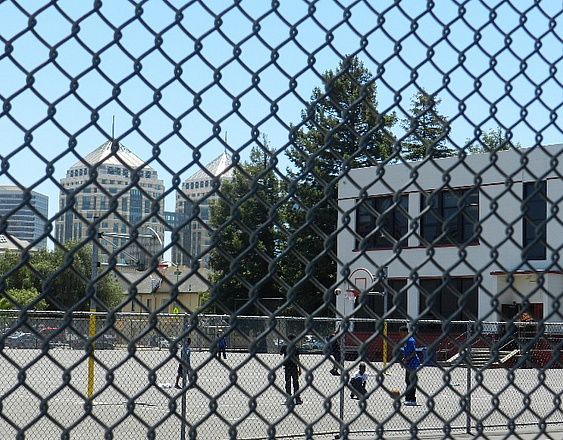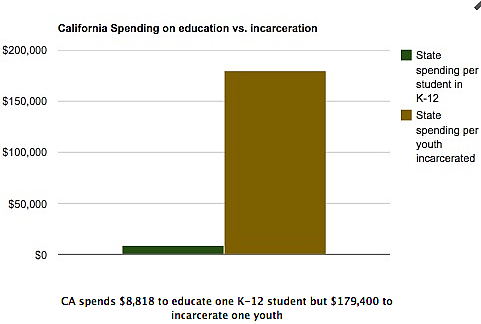Beating The School to Prison Pipeline
Two out of three kids who drop out of Oakland public schools come into contact with the criminal justice system, according to an Oakland Unified School District report. And the dropout rate is 37 percent among Oakland public high school students. In some of Oakland's poorest neighborhoods, more than half of high school students do not graduate.
This story was written by Barbara Grady in collaboration with fellow Micky Duxbury's 10-part investigative series: Lessening the impact of incarceration in Oakland.
Part One: Getting out and staying out: Lessening the Impact of Incarceration on Oakland (Series Overview)
Part Two: Alameda County Ahead of the Curve with Realignment
Part Three: Reducing Recidivism: The Revolving Prison Door
Part Four: Barriers to reentry challenge parolees looking for work, stable lives
Part Five: Changing Your Mind About Doing Time
Part Six: Lessening the Grip of a Criminal Lifestyle
Part Seven: What’s it Like for the Kids When Mom or Dad Are in Jail or Prison?
Part Eight: Beating The School to Prison Pipeline
Part Nine: Teens Struggle When Parents Are In Prison
Part Ten: Helping Youth Feel Safe, Cared for Key to Breaking School-to-Prison Pipeline


Judge Gloria Rhynes leveled with the young Oakland mother whose third grader had missed two months of school.
"Did you know, the California Department of Corrections looks at who is absent in the third grade to figure out how many prison cells they are going to need when those children are adults?" Judge Rhynes, an Alameda County Superior Court judge, asked her as the mother’s case was heard in Truancy Court one morning in early May.
"The correlation is that strong," between missing school in the elementary years and winding up in jail, she said, between not learning third grade skills of reading and multiplication to falling so far behind in middle school that by high school the student drops out, the Judge continued. "I just convicted a 19-year old to 30 years to life. Do you think he had an education? Heck no."
Two out of three kids who drop out of Oakland public schools come into contact with the criminal justice system, according to an Oakland Unified School District report. And the dropout rate is 37 percent among Oakland public high school students. In some of Oakland's poorest neighborhoods, more than half of high school students do not graduate.
The phrase "school-to-prison pipeline" has emerged as a rallying cry in social justice circles. The phrase is shorthand, experts say, for mounting evidence that a poor K-12 education, especially one with a lot of missed classroom time, sets a child up for prison.
"I call it the lack of education to prison pipeline," said Deputy District Attorney Teresa Drenick, who started the Truancy Court program in the Alameda County District Attorney’s office to try to reverse the high rates of chronic absenteeism in city schools.
But the pipeline isn't all about truancy.
"There is a huge connection between people not having access to education and ending up in prison," Jennifer Kim, policy advocate for the Books Not Bars campaign of the Ella Baker Center for Human Rights, said.
The curtailed education that leads kids to drop out by high school is caused by myriad things, including poverty, violence-plagued neighborhoods that traumatize kids and prevent them from focusing – or even getting - to school, use of suspensions for discipline and under-funded schools with crowded classrooms in this era of repeated state budget cuts to education.
But chief signposts that a child’s education is going to fail him or her are chronic absenteeism and frequent suspensions, according to the Urban Strategies Council of Oakland.
Urban Strategies found that in the Oakland Unified School District, half of African-American boys are not on track to graduate from school and key indicators of their trajectory are that 20 percent are chronically absent each year and 18 percent are suspended each year.
In Oakland middle schools, one third of African-American boys are suspended in a year. The risk of falling off the path towards graduation is highest among middle school boys, the data indicated, and suspension was the most common denominator for those at risk.
OUSD has taken on the challenge of turning around its high dropout rate and the problems related to it. Under the direction of Superintendent Tony Smith, the district launched the African American Male Achievement Initiative in 2010 and then last year, began a Restorative Justice pilot program to shift away from the use of suspensions for discipline in favor of using conflict resolution practices. Thirdly, OUSD has been turning campuses into Full Service Community Schools so that it can address the health needs and social well-being of its students in addition to academic needs.
But Smith admits, "We have a lot of work to do" and not much money to do it with.
Oakland Unified has endured years of funding cuts from the state during the recession all while it still recovers from a history of insolvency. It had to cut $122 million from its budget in 2010-11 and another $30 million for the academic year just ending. All of this leaves scant money for new programs.
State government, the main financier of K-12 public education in California, has cut education funding by 14 percent or $7 billion in the last four years, leaving school districts around the state scrambling and eliminating all but the basics, according to California Budget Project statistics.
David Yusem, director of the restorative justice pilot program for OUSD, describes the challenge:
"Our schools are resource poor and operating in crisis mode. They don't have enough time or money or resources to deal with a community of traumatized children."
Rolling out restorative justice from the seven campuses where the pilot program it currently operating to all 101 campuses in the district "is going to take some time" and significant investment, he said. But California's funding of education does not provide much for innovation.
California spends $8,818 to educate each child and teenager in California's K-12 public schools, according to state Department of Education 2010-11 figures. That amount is less per student than what 47 other states spend and about $2,400 below the national average.
Meanwhile California spends $179,400 on each youth it incarcerates in the juvenile justice system in a year, according to the Legislative Analyst Office. So it spends 22 times more to incarcerate a youth than to educate a youth.
California is at a tipping point with how it treats its children and youth.
To cope with the $7 billion in lost funding, California public schools have cut teaching positions by 11 percent over the last four years - losing 32,000 teachers statewide and reduced counseling positions by 20 percent. Some high schools, including Skyline in Oakland, have no guidance counselors.
Few schools have personnel with time to find truant kids or provide extra counseling instead of suspending trouble-making kids.
“We sometimes make decisions not necessarily on what is best for kids, but what is convenient for us,” said Principal Elia Bustamante of the United for Success middle school in Oakland speaking at a press conference this spring about the overuse of suspensions as a discipline tool.
Through institutional soul searching brought on by the Restorative Justice pilot program, Bustamante said United for Success was able to reduce its suspensions by 72 percent this past year.
Average classroom sizes in California are now the biggest in the nation, with a 23-to-1 student-to-teacher ratio, according to state Education Department statistics. Many larger school districts have 30 students in a classroom.
But while it scrimped on education, California increased what it spends on prisons and corrections by 62 percent over the last decade. And data suggests that spending has a poor payback: Ricidivism is 81 percent among youth sent to juvenile justice and 65 percent among adults sent to prison.
"Why are our priorities so skewed that we would not invest in our youth, but instead send them to a juvenile justice system that fails them 80 percent of the time," asked Kim of the Ella Baker Center.
"If you have a business and it fails 80 percent of the time, you're not going to stay in that business or keep doing the same thing," Kim said. "You close it down or you do something different."
Because of the exorbitant cost of juvenile justice, which peaked at $253,312 in 2008-09, and because of a court order to ease overcrowding, the state began reducing its juvenile justice population that year by ordering counties to keep more of their defendants.
But it pays a county $117,000 for each youth the county handles per year - or 14 times what it pays school districts to educate a youth.
The results of California's yearly cuts to education are abysmal state average ratings on standardized tests and a high dropout rate. California public school students score below their peers nationwide on the National Assessment of Educational Progress tests given in math and reading to fourth and eighth grade students.
Only 71 percent of California high school students graduate compared with 74 percent of high school students nationwide.
Michelle Alexander, the civil rights attorney whose newly released book The New Jim Crow has become what some have described as the bible for the civil rights issue of our time, says society paved the way for mass incarceration by gouging money out of schools, particularly inner city schools.
"Many offenders are tracked for prison at early ages, labeled as criminals in their teen years and then shuttled from their decrepit, under-funded inner city schools to brand-new, high-tech prisons," she writes. "The communities and schools from which they came failed to prepare them for the workforce and once they have been labeled criminals, their job prospects are forever bleak."
This story was originally published by Oakland Local.